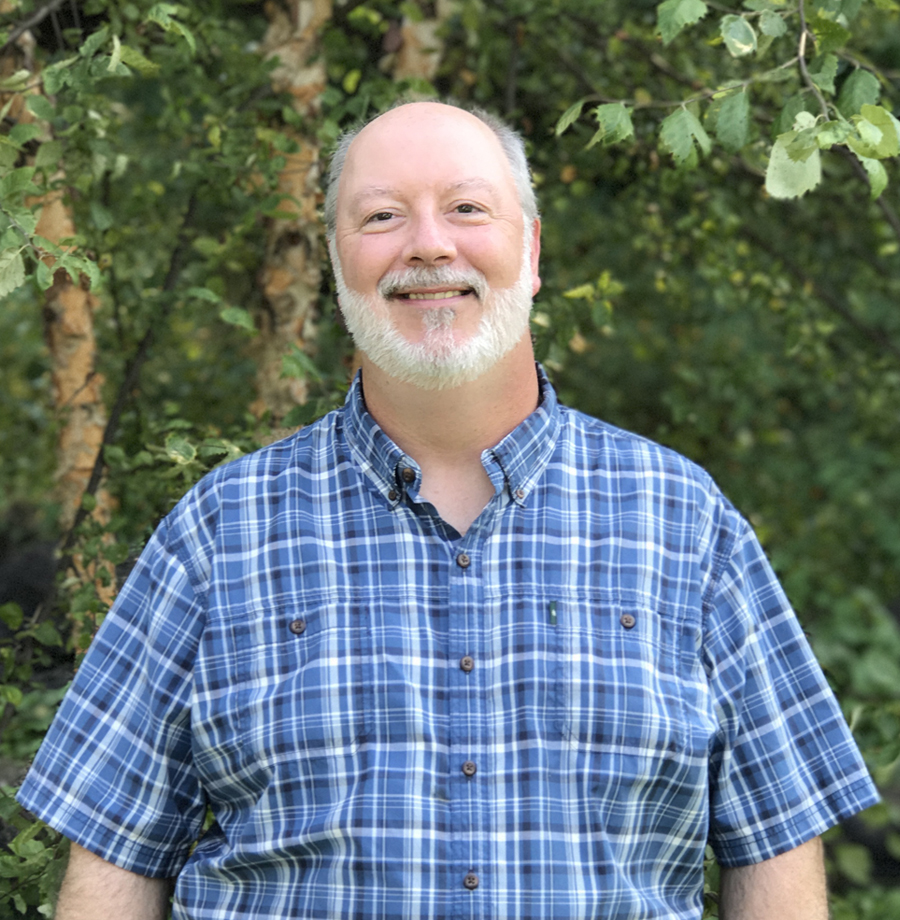
Creating Cleaner Energy Close to Home
Friday, July 12, 2019
Adirondack Park residents are surrounded by hydropower facilities that generate four times more power than all of the residents and businesses inside the Park can possibly use. But almost none of it is available for purchase by local consumers, except in communities with their own electric systems and contracts with the NY Power Authority. Instead, most Adirondack hydropower is transmitted downstate to meet the demands of 19.5 million residents.
Meanwhile, burning fossil fuels to generate electricity causes acid rain, smog and climate change, all of which harm Adirondack ecosystems and local public health. So park residents and business owners who wanted to avoid buying power made from fossil fuels had to find a company somewhere outside of the park and sign a contract to pay them to generate it at a wind or solar facility.
That is beginning to change. The New York Public Service Commission and the NY Independent System Operator are trying to make it easier, for example, for communities to install multi-party solar projects and for local consumers to tap into existing local hydropower. It’s called Community Distributed Generation. As it becomes more popular, more choices will become available to homeowners and businesses inside the Park.
For a look at one of those projects, we asked Emmett Smith, owner/operator of Azure Mountain Power in St. Regis Falls to tell us about his newest venture as Northern Power & Light a power company offering hydro-generated electricity to customers in the Adirondack North Country. Read more from Emmett below.
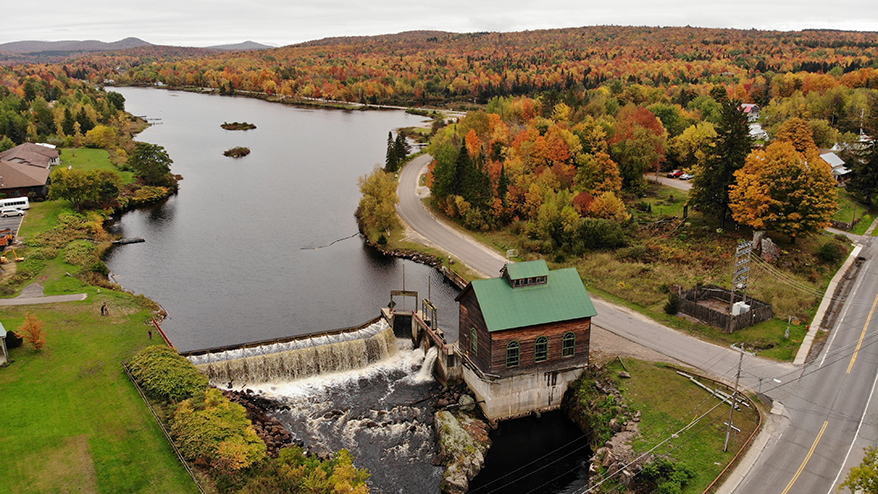 Ariel image of Northern Power and Light Fall 2018
Ariel image of Northern Power and Light Fall 2018
Photo by Sam H Baile
The Washout of Azure Mountain Power
In the spring of 2014, the timber and stone dam at my family’s 750 kW hydroelectric plant Azure Mountain Power (AMP) in St Regis Falls partially washed out. Over 5000 cubic feet per second of water overwhelmed the century-old structure. It was the worst flood we’ve seen since the generators were installed in 1993. Local hydro dam operators like Azure Mountain are truly on the front lines of increasing extremes of climate and weather. And beyond more extreme flooding, local hydro faces challenges from aging infrastructure and decreasing revenues. The wholesale price of electricity has been declining for years, and hydro producers are struggling.'
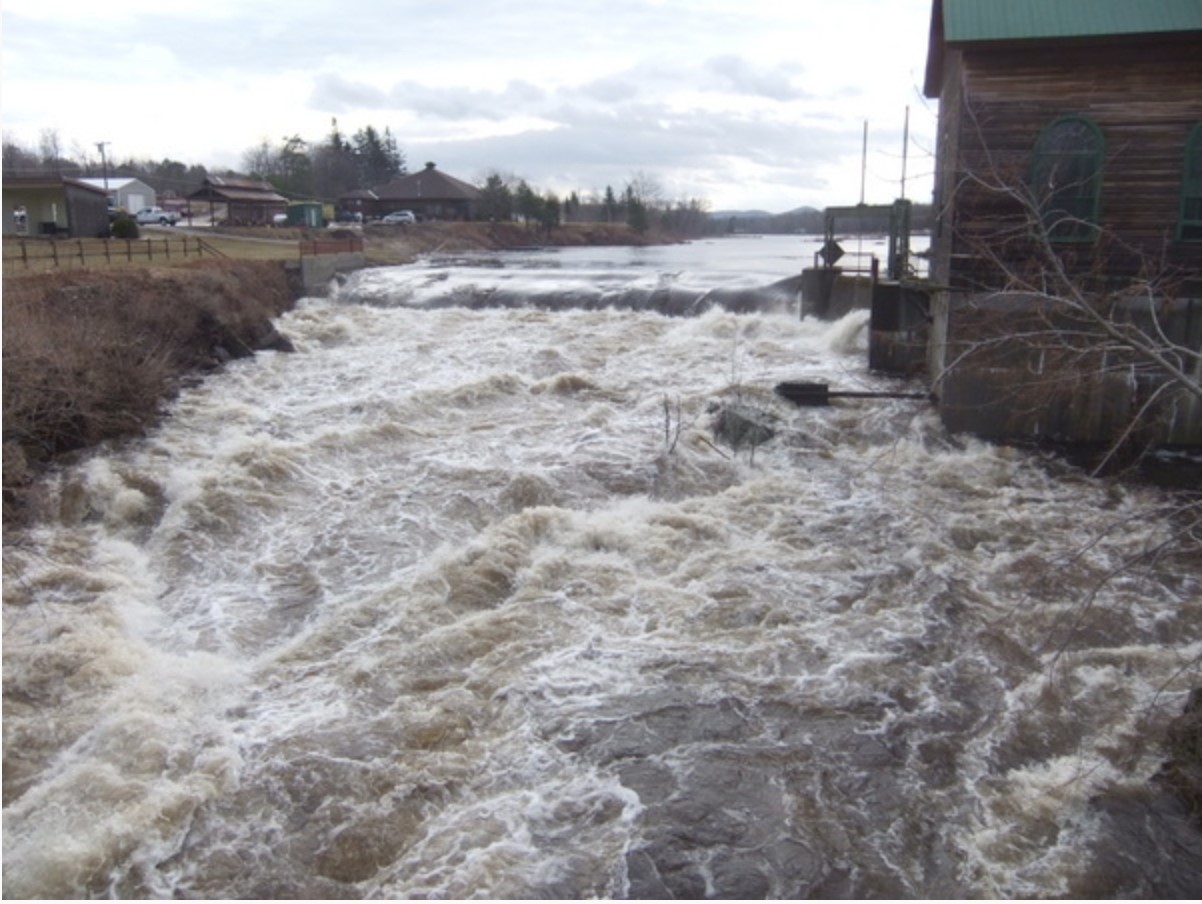 Azure Mountain Power during the flood in 2014. Photo by John Carr, Blue Mountain Engineering, Bangor, NY (via North Country Public Radio.)
Azure Mountain Power during the flood in 2014. Photo by John Carr, Blue Mountain Engineering, Bangor, NY (via North Country Public Radio.)
The low price made it unfeasible to finance the construction of a new concrete dam, and for a time it seemed we were out of options. But in the North Country there is always a way. With a crew of five workmen from St Regis Falls and our 1955 Lorraine cable crane, we rebuilt the 110’ long structure with 600 logs of local tamarack and hemlock and 800 tons of river stone, essentially identical to the dam that was built there in 1880. It was a reminder that the spirit of self-reliance in which this region was settled is still our best guide for how to face the challenges of the present. Building a traditional timber crib dam was also better for the river and the climate, as we did not use any concrete or ship in material from outside the area.
Azure Mountain Power is back up and running, but small hydro plants still can’t compete with cheap natural gas from fracking. New York State subsidies available for the development of wind, solar, and even existing nuclear power plants are not available to existing hydro generators.
Community Supported Local Clean Energy
However, there is another agent of change…community, and the power of consumer choice. We know that whether it is food, furniture, or electricity, when you buy local, you invest in the local economy, lower impacts, and help build self-reliant communities. A new program called Community Distributed Generation (CDG) lets you direct your energy dollar towards a participating renewable facility, such as a small hydro plant or solar array. The result is a significantly higher rate for the local generator, at no extra cost to the consumer. I’m optimistic about small hydro in this region, exactly because of that self-reliant North Country spirit. This model allows people to choose a green energy source and to buy local.
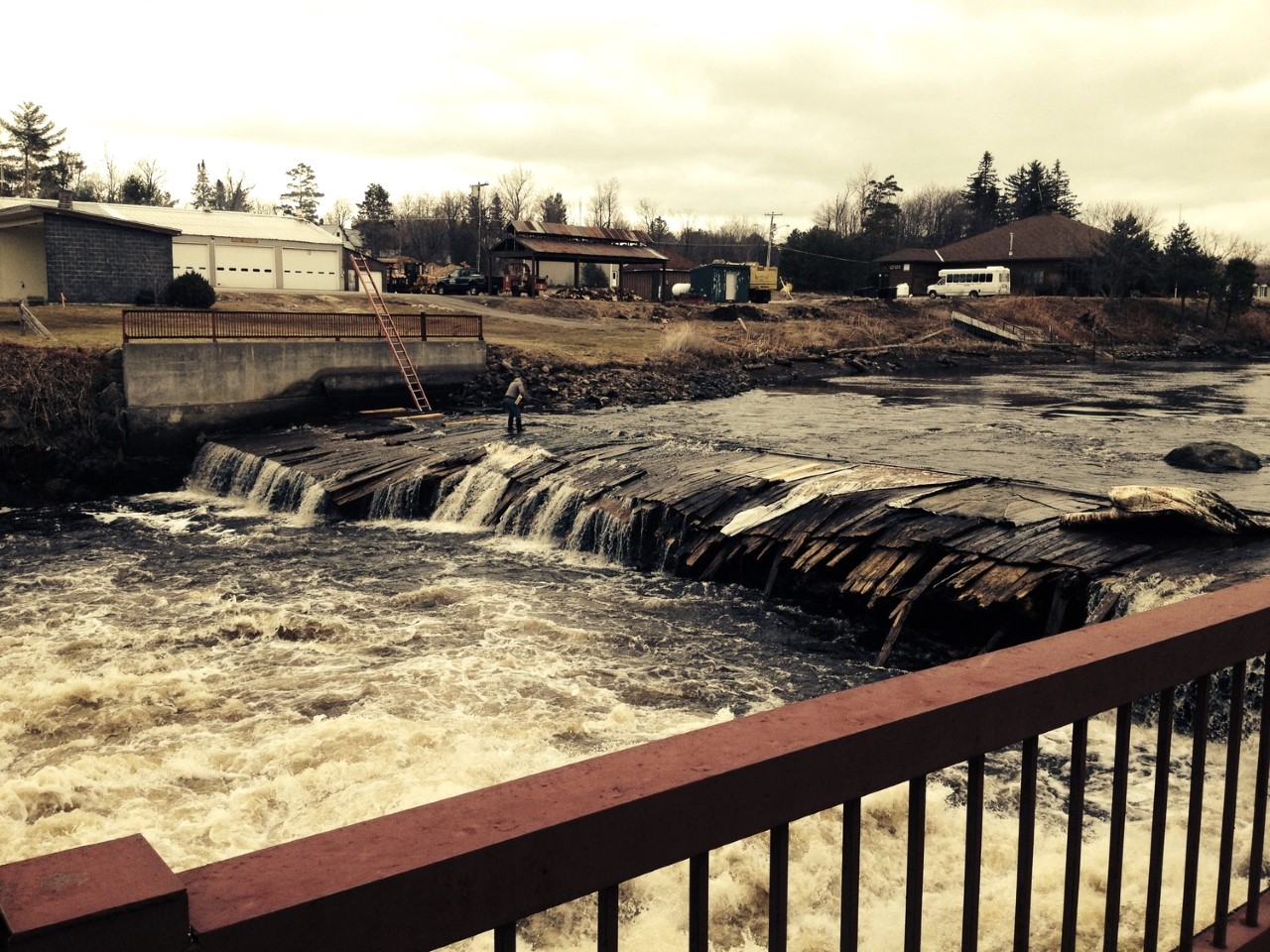 The dam at Azure Mountain Power after to 2014 washout. Photo by Emmett Smith
The dam at Azure Mountain Power after to 2014 washout. Photo by Emmett Smith
The Next Generation
This year, two partners and I founded a new company to market electricity from Azure Mountain Power as well as other local generators, adapting the CDG program to small hydro. The ability to send your energy dollar directly to a local renewable facility is new, but not without historical precedent in this region. We chose the name Northern Power & Light (NP&L) to honor the small local utility companies that used to exist all over the region, powered primarily by hydro. As a result of this legacy, our region already produces many times more power than it consumes, yet in recent decades we have seen little direct economic benefit. The success of CDG has the potential to address this inequity by raising and localizing the value of hydro.
Thinking Small & Protecting Our Landscape
Our region is facing a historic challenge as some of the biggest companies in the world seek to develop new large-scale renewable power projects. We see the tension between maximizing renewable resources and the preservation of our landscape, and our traditional industries. These are important questions to consider, and so I’d like to address the role dams play in our ecology.
In short, there is a big difference between building something new and fixing something old. The original dam at the site of Azure Mountain Power was built around 1880 by the Brooklyn Cooperage, and the surrounding ecosystems have been stable and healthy for well over 100 years. The slow-moving pond above the dam supports a marshland ecosystem and a warm water pike and bass fishery. Downstream of the dam are rippling cataracts and big trout. People have adapted as well, with many camps along the shoreline of the pond, and regular visitors to the trophy trout stream below. The Department of Environmental Conservation (DEC) refers to this as a “historically bisected ecosystem” and manages it similarly to a bisected ecosystem created by a natural falls, or a pond with an outlet stream. They stock walleye above the dam, and trout below.
My family built AMP in the early 1990s, installing electric generators adjacent to the old dam. This was during the first clean energy boom, inspired by the oil crisis and the environmental mindset of Jimmy Carter. At the time, special rates were available to renewable power sources that could be developed without additional ecological impacts. Like nearly all dams in this region, AMP is what is called a “Run-of-River” site, where stream ecology comes first. The DEC specifies the parameters of our operation based on what is healthy to maintain the surrounding ecosystems. We maintain the level of the pond as directed and pass specified minimum flows around the powerhouse at all times, preserving a continuous run of the stream. In most cases, the DEC also has the authority to require the installation of fish passage for migratory species.
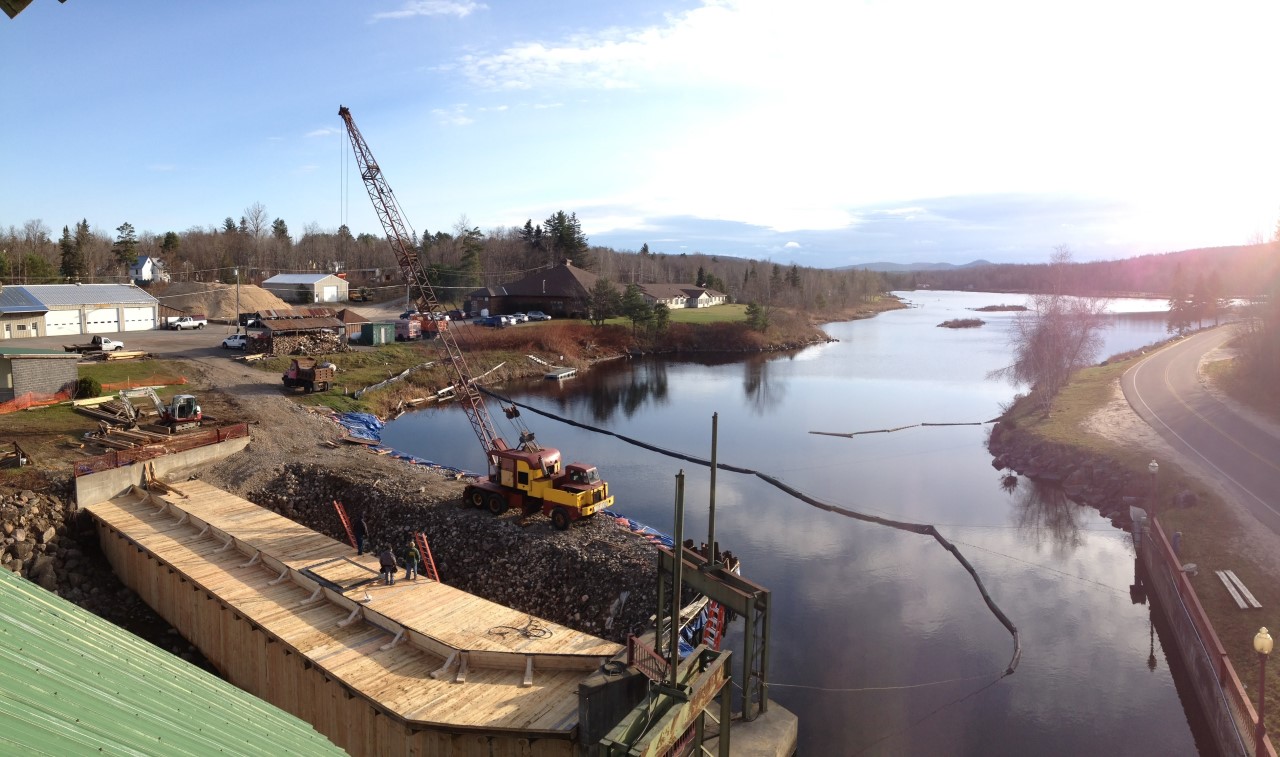 The new dam at Azure Mountain Power after completion in 2014, seen from the roof of the powerhouse.Photo by Emmett Smith
The new dam at Azure Mountain Power after completion in 2014, seen from the roof of the powerhouse.Photo by Emmett Smith
What Happens When a Dam Dies
When dams are removed in our region, the determinative factor is usually safety, as they become unstable with no revenue to support their maintenance over time. In some cases, this can be done with relatively minor disruption to the ecology and community, but there are many dams in this region that are critical infrastructure on which the landscape as we know it depends. Our free enjoyment of these facilities depends on them being profitable to hydro operators, and it is uncertain what will happen if they become uneconomic. Hydroelectric facilities can be inexpensive to operate but are very expensive build, and to fix. Often it is an event, such as a partial washout or mechanical failure, which can cause a company to decide the facility is not worth fixing and walk away. That makes it unpredictable, at a time when facilities are aging (the average age of dams in New York is 81 years) and floods are getting worse. Ultimately abandoned facilities fall back on the community, as has happened in Ausable Forks and Malone in recent years. Those of us who follow the industry closely know there are some very important facilities with uncertain futures.
The Impact of Energy
Energy production invariably has a large impact, which is why it is important that the people most affected receive some benefit, and have some measure of control. Regulators like the DEC are subject to public input. CDG has the potential to create a powerful economic relationship that has not existed for many years. A business that depends on its community is a business that is responsive to its community.
Living close to wild places helps us realize the interdependency of all things, bringing the impacts of our daily lives into focus. Just as our forest pulls carbon out of the atmosphere, our rivers offset carbon-emitting generators. The global movement to reduce carbon emissions has spawned a great many opportunities to “be green,” and it can be hard to weigh value among them. One principle that has emerged across many industries is that there is a clear synergy between buying local and lowering impacts. When we support and benefit from our local resources, we also support sustainable practices and communities.
NP&L is proud to offer the first such opportunity for Adirondack hydroelectric power.
Emmett Smith is the Founder of Northern Power and Light. The company is the first of its kind in the Adirondack Park. The views expressed in this article do not necessarily represent the views of the Adirondack Council. Please see our proposed guidelines for clean energy development for more information.
|

